This article was co-authored by Katie Prendergast. Katie Prendergast is a Certified Personal Trainer, Nutrition Coach, and the Owner of KPxFitness. With over seven years of coaching experience, she has expertise in helping skiers, snowboarders, and hikers build strength and endurance to enjoy more outdoor adventures. Katie earned her Personal Training Certification and Corrective Exercise Specialist Certification from The National Academy of Sports Medicine (NASM) and is a Pain-Free Performance Specialist (PPSC).
There are 11 references cited in this article, which can be found at the bottom of the page.
wikiHow marks an article as reader-approved once it receives enough positive feedback. In this case, several readers have written to tell us that this article was helpful to them, earning it our reader-approved status.
This article has been viewed 213,608 times.
Sick of working in the office 9 to 5? Do you want to get paid to work outdoors? Getting a job at the federal, state, or local level as a wildland firefighter provides you with many opportunities to travel, make great money, lead an active lifestyle, and serve your community through fighting wilderness fires. Most U.S. wildland firefighters work seasonally from May to August, and you should apply for these jobs before the first of the year (though some agencies begin hiring in the fall and train during the winter).[1] Get started today by finding out more about the requirements for becoming a wildland firefighter and how you can apply.
Steps
Building Skills and Qualifications
-
1Meet the initial qualifications. In the US you must be a citizen at least 18 years old with a high school diploma or the equivalent in order to work as a firefighter for federal, state, and local agencies or bureaus.[2]
- Each country has its own unique set of qualifications. Be sure to check the specifications in your jurisdiction, if you live outside of the United States.
- For example, in Canada, you must be 18 years or older, speak English, and complete three training courses.[3]
-
2Brush up on your outdoor skills. It's an enormous help if you're familiar with basic survival skills like assembling a tent, reading a topographic map, using a compass, and tying knots. Much of your time on duty will be spent living outdoors, so knowing camp crafts and having wilderness survival knowledge will give you a leg up.
- Break in your boots. You will be supplied with most items needed (hard hat, leather gloves, fire resistant clothing, backpack, tent, etc.), but you need to purchase your own boots. The US Fish & Wildlife Service recommends you break these in before turning up for duty to avoid blisters, sores, infection, and other concerns.
- Practice hiking with a pack. Increase the distance hiked and weight carried gradually, until you can hike with 45 pounds for several miles.[4]
- For perspective: to qualify as a smokejumper, you would need to complete a hike of three miles in under 90 minutes, carrying a 110-pound pack, over level ground, among other things.
- Complete a fire training course from a local community college, university, or vocational institute. This will give you the basic information you need to get started on the job.[5]
Advertisement -
3Improve your chances by taking classes. If you have no prior experience in wildland firefighting, there are basic classes you may be able to complete locally. This can increase your chances of being hired. The first step would be to complete courses in fire science and emergency medical training. Beyond this, specific educational requirements vary at the federal, state, and local level, so contact the organization you plan to apply with to find out more.
- Earning an associate’s, bachelor’s, or graduate degree in fire science or other related subjects will set you apart from other applicants, but this is not typically required for entry level wildland firefighting positions.
- Check the courses offered in fire science at your local community college or university to see if there is at least one course in wildland firefighting.
- Contact the school to find out if hands-on training is part of the fire science curriculum.[6]
-
4Work as a volunteer firefighter. Many organizations that hire wildland firefighters require previous experience. Volunteering with your local fire department will give you an opportunity to work in the field, receive training, and develop the physical stamina necessary to be an effective wildland firefighter and well qualified applicant.[7]
- To improve your stamina on your down time, try "rucking," or going for a walk with a backpack on. Start with a lightweight backpack, then add weight to it as you build strength and stamina.
- To condition you to hike through wild terrain, set a treadmill to "incline" mode while you walk on it.
- To increase your strength so you can endure long treks and physical exertion, do push ups, pull ups or inverted rows, squats, lunges, step ups, deadlifts, and glute bridges.
-
5Talk to wildland firefighters. This gives you an opportunity to find out more about the job from someone with firsthand experience. They can also give you tips for the application, physical test, new job listings, and how to be successful on the job.
-
6Prepare for potential hazards. Make sure your will, power of attorney, life insurance policies, etc. are all in order prior to taking a position as a firefighter. Wildland firefighting is an extremely hazardous profession. Before you leave for a season, make sure all of your affairs are in order. While training and safety precautions reduce the risk of death for wildland firefighters, it remains a possibility.[8]
- While wildland firefighter safety continues to improve, the job is still very hazardous. In 2013, an entire crew of 19 was lost when their emergency shelters were unsuccessful in protecting them, after they became trapped in unexpected and rapidly deteriorating conditions. [9]
- In recent years, annual deaths have decreased dramatically. Apart from 2013, less than 20 fatalities have occurred annually since 2010. [10]
Ensuring Your Physical Aptitude
-
1Meet the fitness qualifications. Every certified wildland firefighter is required to meet certain physical standards when starting the job. Your physical aptitude for wildland firefighting will be tested through the work capacity test (WCT). Every U.S. agency or bureau requires you to complete this test before becoming a wildland firefighter. Even if your local department doesn't require it, you might not be selected for out-of-state service unless you have qualified.
- The WCT is administered as part of the application process for many agencies. If you don't meet the requirements for the test initially, you have two weeks in which to take it again. If unsuccessful the second time, you will likely not be accepted for the position.
- The WCT is often referred to as the pack test because it requires applicants to hike several miles with a 45-pound pack.
- The WCT is administered when you return to duty each season to ensure you’ve maintained physical aptitude.[11]
-
2Train for the WCT. If you're not in shape already, start your training as soon as possible. Running and hiking holding heavy weights while going up and downhill are excellent forms of exercise to prepare for the WCT. For most agencies with temporary assignments, the fire season starts in May, so you will want to give yourself a few months of proper training before this; beginning in February at the latest. If the WCT is part of the application process, you’ll need to begin your training program earlier in the year.
- Contact the agencies you’re applying with and local fire science programs to find out if there are group training programs for the WCT in your area.
- Get a personal trainer through a local gym. They are great resources to help you safely and successfully reach your training goals, especially if they are familiar with training firefighters.
- Give yourself rest time throughout training. Do not run or hike every day. Instead, start with two or three days of activity each week, and gradually increase to five.
- Set yourself apart from other applicants by completing practice WCTs before applying.[12]
-
3Visit your doctor. Many applicants are required to submit medical clearance from doctor prior to engaging in arduous labor. The United States Forest Service recommends you consult your physician before training to become a wildland firefighter. Substantially increasing your level of activity can be dangerous. If your lifestyle has been mostly inactive, you have a history of a heart condition or chest pain, or you have joint or bone problems that could worsen with a change in physical activity, visiting a physician is essential.[13]
Getting the Job
-
1Search for jobs online. There are a variety of websites where you can look for current wildland firefighting job opportunities. Each site will also provide information about the application process, whom to contact for assistance, job descriptions, and what training or experience is required prior to application. Carefully review this information before applying for a position.
- If you’re interested in applying with US state agencies, there are currently 11 regional organizations that hire wildland firefighters. A full list of these Geographical Area Coordination Centers, with links to their websites can be found at the page.
- One place to find federal jobs is through the US Fish & Wildlife Service at http://jobs.fws.gov. Click the “current job listings” tab, and search for “fire.”
- The US Department of the Interior has a full page devoted to application information specifically for wildland firefighters. This information is processed through the Fire Integrated Recruitment Employment Systems or FIRES. The FIRES recruitment system, application information, and links to current openings can be found in the US at http://www.firejobs.doi.gov
- You can check with US National Park Service’s Fire and Aviation department at http://www.nps.gov/fire. Click on the "Jobs" link. From there, you can search for jobs under "Job Search.” This has customized searches for National Park Service fire-related jobs.
- For US Forest Service applicants, you can also search for wildland firefighter job openings, internships, apprenticeships, and more through the United States Department of Agriculture at http://www.fs.usda.gov/detail/r5/fire-aviation/management/?cid=stelprdb5341420.
-
2Apply to be a wildland firefighter. This is typically a digital process though a few local agencies may still have paper forms. Be aware that filling out applications online can be a little tricky due to the way they are worded and set up. If you’re experiencing difficulties filling out the application, ask for help immediately from the human resource department or other contact at the agency you’re applying with.
- Set aside adequate time to complete the application. The application usually takes about an hour, though it varies between agencies.
- If there’s not a checklist available from the agency you apply with, make your own application checklist to keep track of all necessary steps.
- Before applying for a job, make sure you meet all of the minimum education and experience qualifications.[14]
-
3Pass the application exams. Many federal and state wildland firefighters take two tests as part of the application process. This allows agencies to quickly cut down a pool of applicants, so you must pass this hurdle in order to be hired as a wildland firefighter. The first exam will be a written test with questions on wildland firefighting basics. The second exam is the Candidate Physical Ability test (sometimes known as CPAT), which evaluates each applicant’s endurance, strength, and physical fitness in standardized exercises.[15]
- The written test typically covers things like protective equipment, response procedures, and mechanical reasoning. These topics will all be covered in any basic introduction course to fire science or may be learned from independent study of textbooks or relevant on-the-job training.
- If you aren’t able to complete a course in fire science prior to taking the test, there are a number of online resources you can consult free of charge. Search online for “wildland firefighter written exam prep.”
- There are often study materials available through the agency you apply with.
- Passing the Work Capacity Test (WCT) or "pack test" is essential. This test consists of a three-mile walk carrying a 45-pound pack. You must be able to complete the WCT in 45 minutes or less without jogging or running. Rules may vary as to whether you must wear hiking boots or athletic shoes.
- Every wildland firefighter completes the WCT before returning to work each season.[16]
-
4Complete additional training. Most organizations require wildland firefighters to become certified or to complete one or more training courses. The most common requirement is completion of fire academy training, which may be required prior to application in some cases. Others require specific degrees, course work, or certifications. Some require no prior training at all, but your application will be compared against others. Make sure you know what these requirements are, and if at all possible, complete them in advance to set yourself apart from other applicants.
- Check the website for the federal, state, or local agency you’re applying to. Most sites will have a checklist or outline of the requirements for wildland firefighters. If you’re unsure, contact the organization prior to applying to verify you meet all their prerequisites.[17]
- As an example, in Colorado, one of the most popular areas for wildland firefighting, firefighters must earn the Interagency Incident Qualification Card sometimes referred to simply as the “Red Card”, within a limited time of starting. This is completed through the National Wildfire Coordinating Group.[18]
- If you’re interested in a specialty subfield, or applying for advanced crews, you will need to complete additional training. For example, aviation firefighters complete training through the US Bureau of Land Management or US Forest Service to learn how to safely parachute or rappel into fire areas.
- If you hope to advance within the field, you may need to earn a bachelor’s or graduate degree in fire science, rangeland ecology, or other topics.[19]
- Many excellent firefighters and supervisors have little more education than a high-school diploma and some hours of community college, but offset those credentials with massive job qualifications and reputation based upon experience.
Expert Q&A
-
QuestionI'd like to be on a hotshot crew, so I need to be physically prepared to take on really challenging assignments. How do I improve both my cardiovascular fitness and my endurance so I can fight fires in a large burn radius?
 Katie PrendergastKatie Prendergast is a Certified Personal Trainer, Nutrition Coach, and the Owner of KPxFitness. With over seven years of coaching experience, she has expertise in helping skiers, snowboarders, and hikers build strength and endurance to enjoy more outdoor adventures. Katie earned her Personal Training Certification and Corrective Exercise Specialist Certification from The National Academy of Sports Medicine (NASM) and is a Pain-Free Performance Specialist (PPSC).
Katie PrendergastKatie Prendergast is a Certified Personal Trainer, Nutrition Coach, and the Owner of KPxFitness. With over seven years of coaching experience, she has expertise in helping skiers, snowboarders, and hikers build strength and endurance to enjoy more outdoor adventures. Katie earned her Personal Training Certification and Corrective Exercise Specialist Certification from The National Academy of Sports Medicine (NASM) and is a Pain-Free Performance Specialist (PPSC).
Certified Personal Trainer & Nutrition Coach If you plan to traverse over 10 miles of difficult terrain, I recommend 2-3 conditioning days per week. If you’re doing 2 days, one will be a “long aerobic” effort to build your endurance; the other will be a sprint interval workout. If you’re able to add a third training day, go on a "ruck," which involves walking or hiking with a loaded pack. This will prepare you to carry heavy equipment during a very long trek.
If you plan to traverse over 10 miles of difficult terrain, I recommend 2-3 conditioning days per week. If you’re doing 2 days, one will be a “long aerobic” effort to build your endurance; the other will be a sprint interval workout. If you’re able to add a third training day, go on a "ruck," which involves walking or hiking with a loaded pack. This will prepare you to carry heavy equipment during a very long trek. -
QuestionDo I need to go to a firefighter academy to get hired, and do I need to take a test?
 Community AnswerWell, you have to go to CPR training and get fit for the firefighter job. Besides that, the only education that's really required is a high school diploma, but taking some relevant classes or even getting a fire science degree could increase your chances of getting hired. You will have to take two exams before getting hired: a general written exam to make sure you have the reasoning skills needed for the job, and a physical exam which may involve completing a rough hike while carrying heavy gear.
Community AnswerWell, you have to go to CPR training and get fit for the firefighter job. Besides that, the only education that's really required is a high school diploma, but taking some relevant classes or even getting a fire science degree could increase your chances of getting hired. You will have to take two exams before getting hired: a general written exam to make sure you have the reasoning skills needed for the job, and a physical exam which may involve completing a rough hike while carrying heavy gear. -
QuestionI have a felony conviction. Can I still be a firefighter?
 Community AnswerThere are no federal or state laws in the US that prohibit hiring felons as firefighters. In fact, some excellent wildfire crews are made entirely of currently incarcerated felons.
Community AnswerThere are no federal or state laws in the US that prohibit hiring felons as firefighters. In fact, some excellent wildfire crews are made entirely of currently incarcerated felons.
References
- ↑ http://www.firejobs.doi.gov
- ↑ http://www.nationalfirefighter.com/blogihq/How-to-Become-a-Wildland-Firefighter-INFOGRAPHIC
- ↑ https://www.ontario.ca/page/become-fireranger
- ↑ http://www.fws.gov/fire/downloads/wfjobdesc.pdf
- ↑ http://www.nationalfirefighter.com/blogihq/How-to-Become-a-Wildland-Firefighter-INFOGRAPHIC
- ↑ http://www.firescience.org/how-to-become-a-wildland-firefighter/
- ↑ http://www.firescience.org/how-to-become-a-wildland-firefighter/
- ↑ http://www.aims.edu/academics/fire-science/wildland/prep-guide.pdf
- ↑ http://www.npr.org/2013/12/28/257771391/a-tragic-year-for-wildland-firefighters-ends-in-reflection
- ↑ https://www.nifc.gov/safety/safety_documents/Fatalities-by-Year.pdf
- ↑ http://www.fws.gov/fire/downloads/wfjobdesc.pdf
- ↑ http://www.fws.gov/fire/downloads/wfjobdesc.pdf
- ↑ http://www.aims.edu/academics/fire-science/wildland/prep-guide.pdf
- ↑ http://www.firejobs.doi.gov
- ↑ http://www.firescience.org/how-to-become-a-wildland-firefighter/
- ↑ http://www.aims.edu/academics/fire-science/wildland/prep-guide.pdf
- ↑ http://www.firescience.org/how-to-become-a-wildland-firefighter/
- ↑ http://csfs.colostate.edu/wildfire-mitigation/becoming-a-wildland-firefighter/
- ↑ http://www.firescience.org/how-to-become-a-wildland-firefighter/
About This Article
To become a wildland firefighter, you need to be at least 18 years old, have a high school diploma, and be a U.S. citizen. You'll also want to be familiar with basic outdoor skills, so try to hike and camp as much as possible to learn how to do things like assembling a tent, using a compass, and reading a map. You can also take classes in fire science and emergency medical training to help prepare you for the job and improve your chances of getting hired. To learn how to meet the fitness qualifications to become a wildland firefighter, scroll down!

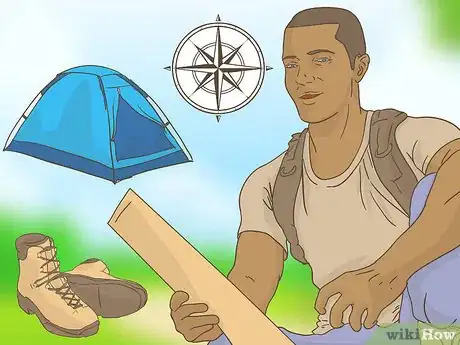
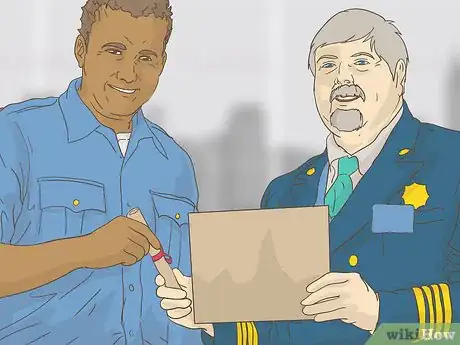
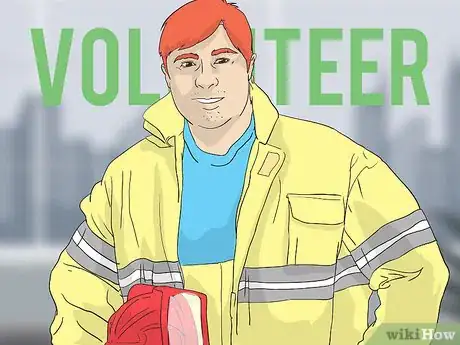
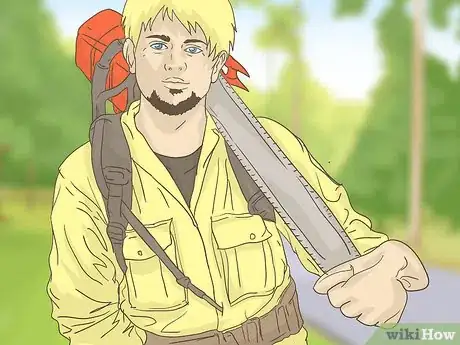


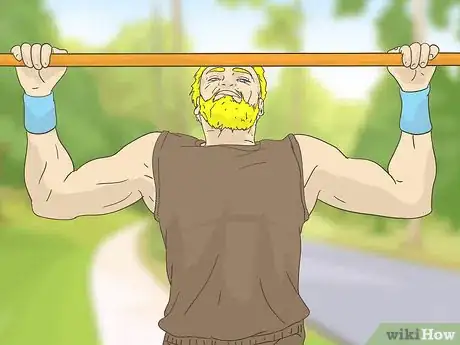






-Step-9.webp)
























-Step-9.webp)




































